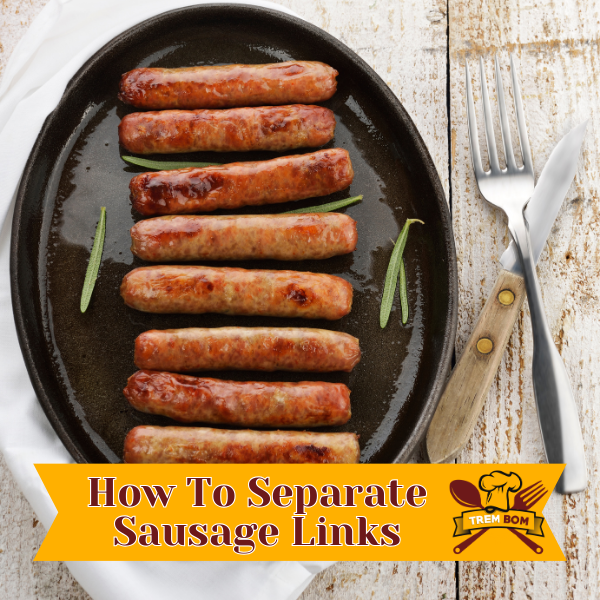
Welcome to our guide on how to separate sausage links! If you’ve ever struggled with separating sausages without breaking or tearing the casings, we’ve got you covered. In this article, we’ll share the best tips and techniques for quick and easy sausage link separation, ensuring perfect cooking results every time. Whether you’re a cooking enthusiast or just looking to elevate your grilling game, these methods will make the process a breeze. Let’s get started!
Key Takeaways:
- Separating sausage links allows for even and thorough cooking.
- Properly preparing the sausages, including thawing them if frozen, is crucial to prevent tearing or breaking of the casings.
- The twist and pull method is a common and effective technique for separating sausage links.
- Using a sharp knife or kitchen shears can also be a useful way to separate sausage links, especially for thicker casings.
- Keeping the sausages cold can make the separation process easier and help preserve the shape of the links.
Why Separate Sausage Links?
Before we dive into the techniques for separating sausage links, let’s discuss why it’s important. Separating sausage links allows for even and thorough cooking. It also makes it easier to portion out the sausages for serving. However, it’s crucial to do it properly to preserve the shape of the links and prevent any damage to the casings.
Preparing the Sausages
Before we delve into the art of separating sausage links, it’s crucial to ensure that the sausages are properly prepared. This step is essential to guarantee a seamless separation process, without any breaks or tears in the casings. Let’s explore the key aspects of preparing sausages for optimum results.
Thawing Frozen Sausages
If your sausages are frozen, it’s important to thaw them completely before attempting to separate the links. Partially frozen sausages can be prone to tearing, making it challenging to achieve clean separations. To thaw the sausages, place them in the refrigerator overnight or follow the manufacturer’s instructions for defrosting.
Easing the Separation
Sometimes, sausages tend to stick together, especially if they have been vacuum-sealed or are slightly moist. In such cases, a simple trick can make the separation process much smoother. Lightly coating the sausages with a small amount of vegetable oil can help reduce friction and prevent sticking, allowing you to separate them without breaking the casings.
Our Expert Tip:
To avoid any potential contamination, always wash your hands thoroughly before and after handling raw sausages. This practice helps maintain hygiene and prevents the spread of bacteria.
| Preparation Tip | Description |
|---|---|
| Thawing Frozen Sausages | Thoroughly thaw the sausages in the refrigerator to avoid tears while separating. |
| Easing the Separation | Lightly coat the sausages with vegetable oil to minimize sticking and facilitate easy separation. |
By following these preparation tips, you’ll be well-equipped to separate sausage links without any hassle or risk of damaging the casings. Now that we have prepared the sausages, let’s explore the various techniques to separate the links seamlessly in the next section.
The Twist and Pull Method
One of the most common and effective methods for separating sausage links is the twist and pull technique. Start by holding the end of one sausage link firmly. Then, twist the link away from the rest of the sausages in one direction until it separates. Be gentle while twisting to avoid tearing the casing. Repeat this process for each link.
| Pros | Cons |
|---|---|
| Quick and easy | Requires manual dexterity |
| No need for additional tools | Possible risk of tearing the casing if not careful |
| Preserves the shape and integrity of the sausages | May not be suitable for individuals with limited hand strength |
Using a Knife or Kitchen Shears
When it comes to separating sausage links, using a sharp knife or kitchen shears is another effective method. This technique is especially handy for thicker or tougher casings. Here’s how you can do it:
- Carefully insert the knife or shears between the links, ensuring that you avoid piercing the casings.
- Apply gentle pressure to cut through the casing and separate the links.
By using a knife or kitchen shears, you have better control over the separation process, allowing you to avoid any tearing or breakage of the casings. This method is particularly useful when dealing with sausages that have a more robust casing.
Expert Tip:
Make sure your knife or kitchen shears are sharp to achieve clean cuts and prevent any accidental slippage that may result in an uneven separation.
Now that you know the best way to separate sausage links using a knife or kitchen shears, you can confidently tackle the task without compromising the integrity of the casings.
Keep Them Cold
To make the separation process easier, it’s essential to keep the sausages cold. When sausages are cold, they become firmer and less likely to stick together, making it easier to separate them without any hassle. If you find that the sausages have become warm or sticky, a simple solution is to place them in the refrigerator for a few minutes. This will help firm them up, making it a breeze to separate the links without compromising their shape.
Maintaining the Casings
When separating sausage links, it’s important to handle the casings with care to prevent tearing or breaking. Maintaining the integrity of the casings is crucial for preserving the shape of the sausages and ensuring the filling stays intact. By utilizing the proper techniques and being gentle throughout the separation process, you can separate the links without tearing and preserve the shape of the sausage links.
Cooking Tips
Once you have successfully separated the sausage links, it’s time to cook them to perfection. You have several cooking methods at your disposal, allowing you to choose the one that suits your taste and preferences the best. Here are some tips for cooking your sausages:
- Grilling: Preheat your grill to medium-high heat. Place the sausages on the grill and cook for about 15-20 minutes, turning them occasionally, until they are browned and cooked through.
- Pan-Frying: Heat a non-stick skillet over medium heat. Add a small amount of oil or butter to the skillet, then place the sausages in the pan. Cook for about 10-15 minutes, turning them occasionally, until they are browned and cooked through.
- Baking: Preheat your oven to 375°F (190°C). Place the sausages on a baking sheet lined with parchment paper. Bake for about 20-25 minutes until they are browned and cooked through, flipping them halfway through the cooking time.
Remember to keep an eye on the sausages while cooking to ensure they don’t overcook or burn. Properly separated and cooked sausages will result in an even cook, with juicy and flavorful links. Enjoy!
Serving Suggestions
Now that you have mastered the art of separating sausage links, it’s time to think about how to serve them. Sausages can be enjoyed in various ways, whether on their own, in sandwiches, or as part of exciting recipes. Let your creativity run wild and experiment with different condiments, toppings, and sides to elevate your sausage dishes.
Here are some tips for serving sausage links:
- Classic Hot Dog: Serve your separated sausage links in a soft, toasted hot dog bun. Top with your favorite condiments like ketchup, mustard, relish, and onions.
- Sausage and Peppers: Sautee sliced bell peppers and onions until tender, then add in your cooked sausage links. Serve in a roll or on a bed of rice or pasta for a satisfying meal.
- Breakfast Skillet: Cut your separated sausage links into bite-sized pieces and cook them with diced potatoes, onions, and bell peppers. Top with a fried egg for a hearty breakfast option.
- Sausage and Mash: Serve your sausage links alongside creamy mashed potatoes and your favorite gravy. Add a side of steamed vegetables for a well-rounded meal.
- Sausage and Salad: Slice your cooked sausage links and toss them with fresh greens, cherry tomatoes, cucumbers, and a tangy vinaigrette dressing for a refreshing and light meal option.
Remember, the possibilities are endless when it comes to serving sausage links. Don’t be afraid to get creative and try new flavor combinations. Whether you’re hosting a barbecue, enjoying a family dinner, or preparing a quick lunch, serving deliciously separated sausage links will always be a hit!
Cleaning Up
After separating sausage links, it’s important to clean up properly to maintain good hygiene. Here are some steps to follow:
- Dispose of any plastic wrap or packaging that the sausages came in. This will help prevent any cross-contamination.
- Wash your hands thoroughly with soap and water for at least 20 seconds to remove any bacteria or germs.
- Clean any surfaces or utensils that came into contact with the raw sausages. Use hot, soapy water and a scrub brush to ensure proper cleaning.
By following these cleaning steps, you can ensure that your cooking area remains clean and free from any potential contaminants. This will help keep you and your family safe and prevent any foodborne illnesses.
| Step | Action |
|---|---|
| 1 | Dispose of packaging |
| 2 | Wash hands thoroughly with soap and water |
| 3 | Clean surfaces and utensils |
Conclusion
Separating sausage links can seem like a challenging task, but with the right techniques, it can be quick and easy. By following the tips and methods we’ve shared, you’ll be able to separate sausage links without breaking or tearing the casings.
Remember to prepare the sausages properly by ensuring they are fully thawed and, if necessary, lightly coated with vegetable oil to prevent sticking. The twist and pull method is a popular technique that involves gently twisting the sausages to separate them. Alternatively, you can use a sharp knife or kitchen shears to cut through the casings with care.
Keeping the sausages cold will make the separation process smoother, and being gentle with the casings will help maintain their integrity. Once the sausages are separated, you can cook them to perfection and enjoy delicious meals with intact, flavorful links. Whether you grill, pan-fry, or bake them, the properly separated sausages will ensure even cooking and great taste.
With practice, you’ll become a pro at separating sausage links. So don’t worry, give it a try, and soon you’ll be impressing your guests or family with your quick sausage link separation skills!
FAQ
How should I prepare the sausages before separating the links?
Make sure the sausages are fully thawed if they were frozen. Lightly coat them with a small amount of vegetable oil if they are sticking together.
What is the twist and pull method for separating sausage links?
Hold the end of one sausage link firmly and twist it away from the rest of the sausages in one direction until it separates. Repeat for each link, being gentle to avoid tearing the casing.
Can I use a knife or kitchen shears to separate sausage links?
Yes, carefully insert a sharp knife or kitchen shears between the links, avoiding piercing the casings. Apply gentle pressure to cut through the casing and separate the links.
How can I make the sausage separation process easier?
Keep the sausages cold, as they will be firmer and less likely to stick together. If they become warm or sticky, place them in the refrigerator for a few minutes to firm up.
How do I maintain the integrity of the casings when separating sausage links?
Be gentle and delicate with the casings to prevent tearing or breaking. Handle the sausages with care to preserve the shape and prevent the filling from spilling out.
What are some tips for cooking the separated sausage links?
You can grill, pan-fry, or bake the sausages according to your preference. Properly separated and cooked sausages ensure even cooking and a juicy, flavorful result.
What are some suggestions for serving sausage links?
Sausages can be enjoyed on their own, in sandwiches, or as part of various recipes. Get creative and experiment with different condiments, toppings, and sides to elevate your sausage dishes.
How should I clean up after separating sausage links?
Dispose of any plastic wrap or packaging, and wash your hands thoroughly with soap and water. Clean any surfaces or utensils that came into contact with the raw sausages to prevent cross-contamination.





